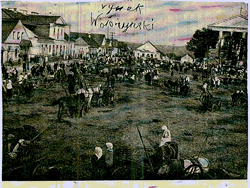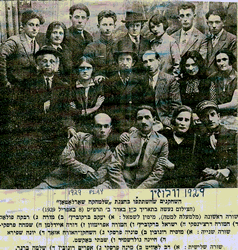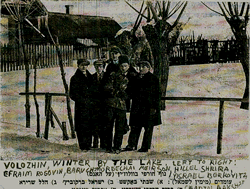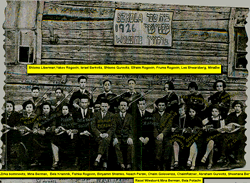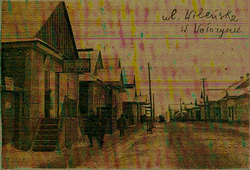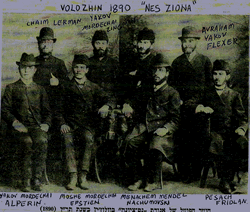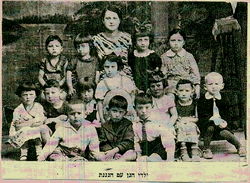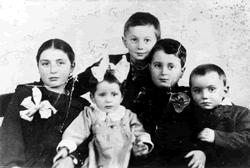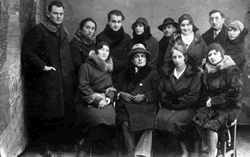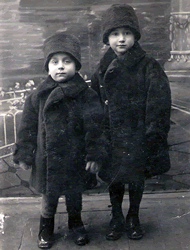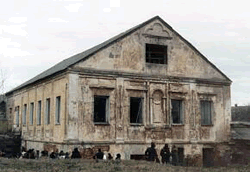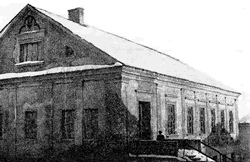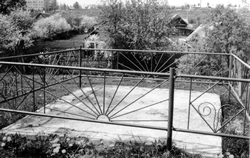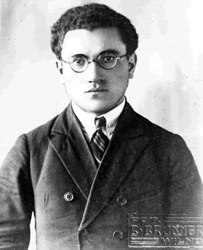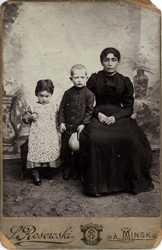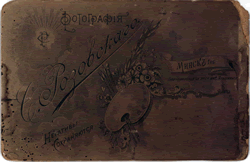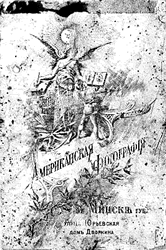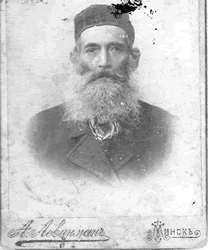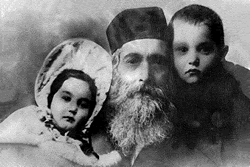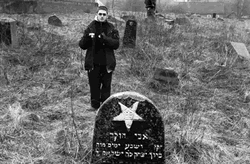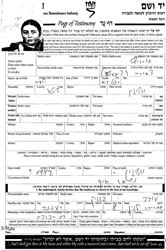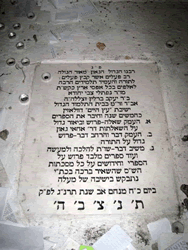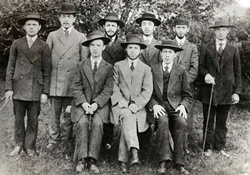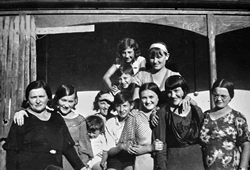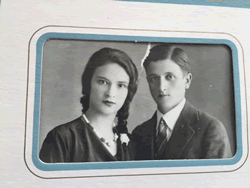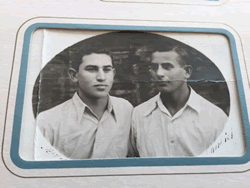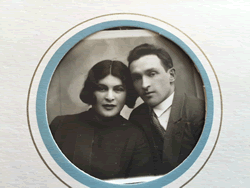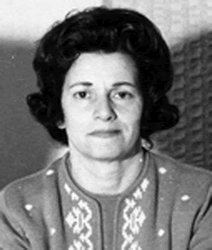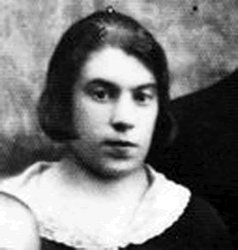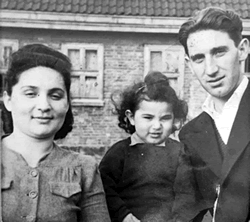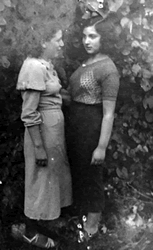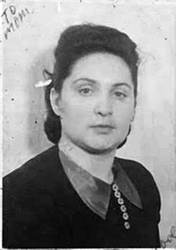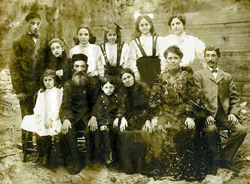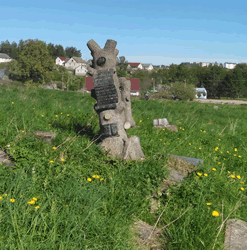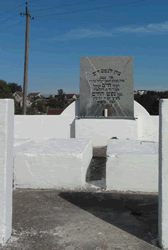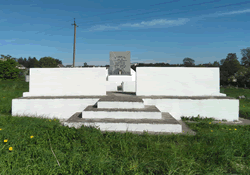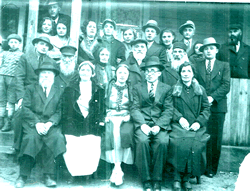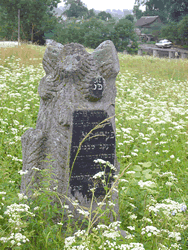|
#vol_1
|
#vol_2
|
#vol_3
|
|
#vol_4
|
#vol_5
|
#vol_6
|
#vol_7 |
#vol_8 |
#vol_9 |
#vol_10: Grandchildren of Isaac and Sara-Ester Shriro: Yaacov Chlopsky and Shmuel Chlopsky (Children of Meir Chlopsky and Miryam nee Shriro), Shmuel Shriro and Dreyzl Shriro (children of Heshel Shriro and Rivka nee Brodno), Tzipora Gurevich ( daughter of and Avraham Gurevich and Sonia nee Shriro. All with their parents and grandfather - victims of the holocaust Picture given by their first cousin: Oded Dweck, son of Mina Shriro from Volozhin |
#vol_11: From: Porat Moshe <poramo@netvision.net.il> The picture attached presents my mothers circle of friends. Standing One of his sons (now in America) started the Zionist activity in For one of the Zionist Congresses he received Shekels. I bought one |
#vol_12 Two Moniks: der Greysser un der Kleyner, My cousin & I (M.Perelman/ |
#vol_13 Volozhin, 1938, Vilna Street promenade. M. Porat |
#vol_14: Yeshivaworld helps save famed Volozhin Yeshiva building |
#vol_15: Yeshivaworld helps save famed Volozhin Yeshiva building |
#vol_16: A fenced concrete slab above the site of a mass grave of the Jews of Volozhin |
#vol_17: The Jewish cemetery in Volozhin. |
#vol_18: A stone monument in memory of the Jews of Volozhin who perished in the Holocaust. |
| #vol_19: Noach Gurewic of Volozhin, a student in the teacher training seminary of the "Tarbut" Hebrew educational network in Vilna |
#vol_20: Pictured; My 2nd great aunt Nechama Melzer Lipschiz. Pictured here with my grandmother Rose and great uncle Sam. In 1909 my grandmother Rasche/Rose Solladuha LaSalle and her brother Schmul/Samuel Solladuha Lasalle were accompanied by their aunt Zirel Kunin Melzer and first cousin Nordiech Lipschiz and brought to Cleveland, Ohio via Baltimore, Maryland via Bremen via Krosnoje, Vilna. Sam states on his citizenship papers that he was born 1896 in Volozhin, Russia which isn't far from Minsk. Cindy Ellen Glass |
#vol_21: Back of picture of my 2nd great aunt Nechama Melzer Lipschiz of Krasnoje. Pictured here with my grandmother Rasche and great uncle Schmul. Cindy Ellen Glass |
#vol_22: Pictured; My great grandmother Ita Basha Melzer of Volozhin. She married Yanya Solladuha/Jakob Lasell/Jacob LaSalle (born March 18, 1867 in Ashmany, Russia) She died between 1898 and 1909 in Minsk. Pictured here with children: Rose and Samuel. In 1909 my grandmother Rasche/Rose Solladuha LaSalle and her brother Schmul/Samuel Solladuha Lasalle were accompanied by their aunt Zirel Kunin Melter and first cousin Nordiech Lipschiz and brought to Cleveland, Ohio via Baltimore, Maryland via Bremen via Krosnoje, Vilna. Samuel states on his citizenship papers that he was born 1896 in Volozhin, Russia. Cindy Ellen Glass |
#vol_23: Back of picture of my great grandmother Ita Basha Melzer of Volozhin. She married Yanya Solladuha/Jakob Lasell/Jacob LaSalle (born March 18, 1867 in Ashmany, Russia) She died between 1898 and 1909 near Minsk. Pictured here with children: Rasche and Schmul. Cindy Ellen Glass |
#vol_24: Pictured; Movsha Melzer of Volozhin/Minsk submitted by the 2nd great granddaughter of Movsha Melzer and Mary Saladeiche. Cindy Ellen Glass |
#vol_25: Pictured; My 2nd great uncle Shimon Meltzer of Volozhin/Minsk and his niece Rasche and nephew Schmul. Submitted by the 2nd great granddaughter of Movsha Melzer and Mary Saladeiche; Cindy Ellen Glass |
#vol_26: |
#vol_27: Tzipora Gurevitz was born in Wolozyn to Sonia nee Shrira and Avraham. She was murdered with her parents in 1942 in Wolozyn This information is based on a Page of Testimony submitted by her cousin Oded. |
#vol_28: A picture of the grave of the Natziv From: Meir Bar Ilan (the Natziv great grandson) |
#vol_29: Does anyone recognize the hats/fashion? Do they have any significance? |
#vol_30: Sonia Fogelman, Tilly Isserow, Rachel Shmukler, Chaim Goldsmith, Gertie Gershator, Eve Sudar, Annie ( Chyena) Handelson, Alice |
#vol_31: Eliyahu Perski, my mom's eldest brother, with his wife |
#vol_32: Aron Rogowin on the left with a friend Yankel (Yaakov) Rogowin ( the two are not related) |
#vol_33: Zalman Perski ( my mother's brother) top right submitted by Mark Rogowin |
#vol_34: Sonya nee Perski ( my mom's sister) with her husband Simcha Perski ( she did not have to change her last name after marriage) submitted by Mark Rogowin |
#vol_35: Rifka Marks (nee Rogowin) Gender: Female |
#vol_36: Nechama Rogowin Birth:1910 Immediate Family: Daughter of Moshe Rogowin and Hinde Morduchowicz |
#vol_37: My mother Feygel Perski wife of Aron Rogowin, daughter of Yosef and Tzirl Perski, of Volozhin . The child is her son Yosef . I think the pictures were taken in a DP camp in Kassel Germany around 1948. The gentleman in the picture is Zelik Rogovin , brother of Aron Rogowin who was in the partisians near Minsk. Mark Rogowin |
#vol_38: My mom Feygel nee Perski and her friend Rochel Golub Weinstein. They were childhood friends. The photo was taken in Volozhin probably in early 1930's. |
#vol_39: My mother Feygel nee Perski, a holocaust survivor. She was the wife of Aron Rogowin, daughter of Yosef and Tzirl Perski, of Volozhin
Mark Rogowin
|
#vol_40: My great grandmother, Minnie "Mindel" Dithy bat Eliyahu Persky, (affectionately called "Minna Disha"), who is seated front row, 4th from the left, and my great grandfather, Eliezer Mordechai ben Tzvi Persky, seated front row 2nd from the left. The other people in the photo are my great aunt Fanny Persky Jacobs, her husband Joseph Jacobs and their children. |
#vol_41: Volozhin Jewish cemetery. The grave of of a woman named Sara who passed away at the age of 36. Submitted by: Allan Dolgow and his cousin Natalia V. Tronchinskaya (Oksengorn) |
#vol_42: Volozhin's Jewish cemetery. The grave of The famed Rabbi Chaim of Volozhin. Submitted by: Allan Dolgow and his cousin Natalia V. Tronchinskaya (Oksengorn) |
#vol_43: Volozhin's Jewish cemetery. The grave of The famed Rabbi Chaim of Volozhin. Submitted by: Allan Dolgow and his cousin Natalia V. Tronchinskaya (Oksengorn) |
#vol_44: |
#vol_45: |
#vol_46: |
#vol_47: |
#vol_48: |
|
|
|
|
Please share your comments or photos or links for posting on our Guestbook Page here: egl.comments@gmail.com
I hope that everything is alright with you.
A few groups of American tourists had a chance to see
the exhibit in Volozhin yeshiva that you have
graciously sponsored.
Last week a class of student from the local high school
have visited the exhibit.
I've send there our historian who during 1 hour told the
kids the history of Volozhin yeshiva.
Last week we have received a letter from the Belorussian
embassy in Israel saying that Shimon Peres is willing
to participate in reconstruction of the Volozhin Yeshiva.
I will keep you inform regarding this subject.
Best regards,
Yuri Dorn
Coordinator of Jewish Heritage
Research Group in Belarus
220002 Minsk
13B Daumana St.
tel/375-172-345612
fax/375-172-343360
VOLOZHIN
(POL. WOLOZYN)
TOWN IN SOUTHERN MOLODECHNO OBLAST, BELORUSSIA.
IN POLAND BEFORE 1793 AND BETWEEN 1921 AND 1945.
JEWS WERE LIVING IN VOLOZHIN IN THE 16TH CENTURY. THEY NUMBERED 383 IN
1766, 2,452 IN 1892, AND 1,434 IN 1921; OUT OF 5,600 INHABITANTS IN 1931,
THE LARGE MAJORITY WERE JEWS. THEY WERE LARGELY OCCUPIED IN SMALL-SCALE
COMMERCE, FOREST INDUSTRIES, FLOUR MILLING, TANNING, BRICKMAKING, AND
CRAFTS FOR THE REQUIREMENTS OF THE AGRICULTURAL LOCALITY. IN WORLD WAR II,
ON THE EVE OF THE HOLOCAUST, ACCORDING TO ESTIMATES BY SURVIVORS, THERE
WERE APPROXIMATELY 3,000 JEWS IN VOLOZHIN. THEY WERE "LIQUIDATED" IN
THREE AKTIONEN, THE FIRST FOLLOWING THE GERMAN OCCUPATION OF THE TOWN,
THE SECOND ON MAY 10, 1942, AND THE THIRD IN SEPTEMBER 1942.
VOLOZHIN ACQUIRED IMPORTANCE IN JEWISH LIFE IN LITHUANIA AND RUSSIA IN THE
19TH CENTURY FROM ITS YESHIVAH FOUNDED BY CHAYYIM VOLOZHINER, CALLED
ETZ CHAYYIM. IT WAS MAINLY ESTABLISHED TO SERVE AS A BARRIER TO
THE SPREAD OF CHASIDISM, ESPECIALLY AMONG THE YOUTH WHEN IT BECAME CLEAR
THAT THE STRONG OPPOSITION TO CHASIDISM HAD BEEN UNABLE TO HALT ITS
ADVANCE. R. CHAYYIM CONSIDERED THAT IT WAS THE PILPUL METHOD OF YESHIVAH
TEACHING, DIVORCING STUDY OF THE TALMUD FROM ITS HALAKHIC FOUNDATIONS, THAT
WAS THE REASON FOR THE DISSATISFACTION AMONG THE YOUTH AND THAT PUSHED
MANY OF THEM INTO THE ARMS OF CHASIDISM BECAUSE OF THE RELIGIOUS STIMULUS
AND INSPIRATION IT OFFERED. TWO YESHIVOT ALREADY EXISTED IN VILNA WHEN R.
CHAYYIM DECIDED TO ESTABLISH THE YESHIVAH IN VOLOZHIN. R. CHAYYIM'S
ENDEAVORS PREVENTED THE YESHIVAH FROM BECOMING A MERELY LOCAL INSTITUTION,
AND MADE IT INTO A FOUNDATION SUPPORTED BY THE WHOLE OF JEWRY; IT THUS
BECAME A PROTOTYPE FOR THE LITHUANIAN YESHIVOT FOUNDED SUBSEQUENTLY.
TEACHING IN THE YESHIVAH BEGAN WITH ONLY TEN STUDENTS, BUT IT RAPIDLY
ACQUIRED A NAME AMONG THE JEWISH PUBLIC. IT BECAME SO HIGHLY ESTEEMED
THAT THE MILITARY GOVERNOR OF LITHUANIA IN 1813, DURING THE NAPOLEONIC
WARS, ISSUED A DOCUMENT OF PROTECTION TO R. CHAYYIM INSTRUCTING ALL
MILITARY UNITS "TO SAFEGUARD THE CHIEF RABBI OF VOLOZHIN, CHAYYIM BEN
ISAAC, HIS SCHOOLS AND EDUCATIONAL INSTITUTIONS... AND TO EXTEND TO THE
ABOVE-MENTIONED CHIEF RABBI EVERY ASSISTANCE AND PROTECTION". THE
NUMBER OF STUDENTS HAD ALREADY RISEN TO 100. AFTER R. CHAYYIM'S DEATH IN
1821 HIS SON R. ISAAC SERVED AS PRINCIPAL OF THE YESHIVAH. AROUND
THIS TIME (1824) THE RUSSIAN AUTHORITIES DECIDED TO CLOSE THE YESHIVAH
FOR REASONS THAT ARE NOT CLEAR. DESPITE THE OFFICIAL ORDER PROHIBITING
ITS EXISTENCE, THE YESHIVAH CONTINUED TO FUNCTION AND EXPAND. THE NUMBER OF
STUDENTS ROSE TO 200 AND ITS BUILDINGS WERE ENLARGED. THE HEAD OF VOLOZHIN
YESHIVAH WAS CONSIDERED AT THE TIME TO BE AMONG THE LEADERS OF RUSSIAN
JEWRY, EVEN BY THE AUTHORITIES, AND WHEN IN 1843 THE GOVERNMENT DECIDED, IN
LINE WITH THE RECOMMENDATIONS OF ITS "JEWISH COMMITTEE", TO CONVENE A
CONFERENCE OF RABBIS TO DISCUSS PROBLEMS OF JEWISH EDUCATION, R.
ISAAC WAS INVITED TO ATTEND. A CONTROVERSY HAD ALREADY BEGUN IN THE YESHIVAH,
BECAUSE, IN CONTRADICTION TO THE TRADITION LAID DOWN BY ITS FOUNDER, R.
ELIEZER ISAAC INCLINED TO FAVOR PILPUL, AND HAD A FOLLOWING AMONG THE
STUDENTS. AFTER THE DEATH OF RABBI ISAAC IN 1849, R. ELIEZER FRIED WAS
APPOINTED PRINCIPAL OF THE YESHIVAH AND R. NAPHTALI TZEVI JUDAH BERLIN
THE VICE-PRINCIPAL. R. ELIEZER ISAAC DID NOT LIVE MUCH LONGER, AND AFTER
HIS DEATH IN 1854, WHEN BOTH R. BERLIN AND R. CHAYYIM'S GRANDSON, R.
JOSEPH BAER SOLOVEICHIK, WERE BOTH APPOINTED PRINCIPALS, A SEVERE
DISAGREEMENT BROKE OUT OVER THE METHOD OF INSTRUCTION, IN WHICH R. JOSEPH
BAER FAVORED THE PILPUL METHOD, AND HAD MANY SUPPORTERS AMONG THE YESHIVAH
STUDENTS. WHEN THE CONTROVERSY THREATENED TO ENDANGER THE EXISTENCE OF THE
YESHIVAH, A DELEGATION OF PROMINENT LITHUANIAN RABBIS WENT TO VOLOZHIN IN
ORDER TO SETTLE THE CONTROVERSY. THE COMMITTEE RULED THAT R. BERLIN SHOULD BE
THE PRINCIPAL OF THE YESHIVAH WHILE R. JOSEPH BAER SHOULD SERVE AS HIS
DEPUTY. IN 1865 R. JOSEPH BAER LEFT THE YESHIVAH TO SERVE AS RABBI OF
BREST-LITOVSK (BRISK). R. RAPHAEL SHAPIRA, SON-IN-LAW OF R. BERLIN, WAS
APPOINTED IN HIS PLACE, SERVING IN THIS POSITION UNTIL 1881. HIS SUCCESSOR
WAS R. CHAYYIM SOLOVEICHIK, SON OF JOSEPH BAER AND GRANDSON OF R. BERLIN.
AT THE END OF THE 1850S THE GOVERNMENT RENEWED THE CAMPAIGN AGAINST THE
CHADARIM AND YESHIVOT. IT WAS HELPED BY A NUMBER OF THE MASKILIM WHO SENT
MEMORANDA TO THE STATE- APPOINTED "JEWISH COMMITTEE" REQUESTING THAT THE
YESHIVOT SHOULD BE CLOSED DOWN AS "NURSERIES OF FANATICAL RABBIS".
IN APRIL 1858 THE YESHIVAH WAS CLOSED DOWN BY ORDER OF THE AUTHORITIES ON
THE GROUND THAT THE SYLLABUS HAD NOT BEEN SUBMITTED FOR APPROVAL TO THE
MINISTRY OF EDUCATION.
PROMINENT JEWS IN VILNA AND MINSK SENT A REQUEST TO THE AUTHORITIES TO
PERMIT THE YESHIVAH TO REMAIN OPEN. DESPITE ALL THE EFFORTS ON THE PART OF
THE JEWS, THE AUTHORITIES DID NOT RESCIND THEIR DECISION. HOWEVER, LIKE
THE ORDER OF CLOSURE OF 1824, IT DID NOT HAVE NOTICEABLE PRACTICAL
EFFECTS. THE NUMBER OF PUPILS CONTINUED TO GROW, REACHING 300 AT THE END
OF THE 1870S AND 400 AT THE END OF THE 1880S, BY THEN ALSO ATTRACTING
STUDENTS FROM OUTSIDE RUSSIA, FROM ENGLAND, GERMANY, AUSTRIA, AND EVEN
AMERICA. A DAILY PROGRAM WAS ESTABLISHED FOR THE STUDENTS. PRAYERS WERE
HELD AT 8 A.M., AND THEY THEN TOOK BREAKFAST. AFTERWARD THE WEEKLY
PORTION WAS READ AND EXPLAINED BY THE PRINCIPAL OF THE YESHIVAH. STUDY
PROCEEDED FROM 10 A.M. TO 1 P.M., DURING WHICH THE SUPERVISOR ENSURED
THAT NONE OF THE STUDENTS MISSED STUDY. THERE FOLLOWED THE LECTURE
(DELIVERED IN THE 1880S BY R. CHAYYIM SOLOVEICHIK, SON OF R. JOSEPH BAER,
IN THE FIRST PART OF THE WEEK, AND BY R. BERLIN IN THE SECOND). THE MIDDAY
MEAL FOLLOWED. THE STUDENTS RETURNED TO THE YESHIVAH AT 4 P.M., HELD
MINCHAH, AND STUDIED UNTIL 10 P.M. EVENING PRAYERS WERE THEN HELD, PRECEDING
SUPPER. MANY WOULD RETURN TO THE YESHIVAH AND STUDY UNTIL MIDNIGHT. THEY
WOULD SLEEP UNTIL 3 A.M. AND RETURN TO STUDY UNTIL THE MORNING.
IN THE 1860S OPPOSITION BEGAN TO BE VOICED IN THE JEWISH PRESS TO THE
YESHIVOT. THE EXTREME MASKILIM DEMANDED THAT THEY SHOULD BE CLOSED DOWN;
OTHERS CRITICIZED THEIR SYSTEM OF STUDY AND ITS CONTENTS AND WISHED TO
INTRODUCE GENERAL SUBJECTS, AS HAD BEEN INSTITUTED IN THE
RABBINICAL SEMINARIES IN GERMANY AND IN WESTERN COUNTRIES. R. BERLIN
ADAMANTLY OPPOSED ANY CHANGES OF THIS NATURE. A NUMBER OF JEWISH COMMUNAL
LEADERS REGARDED IT NECESSARY TO DEMONSTRATE TO THE AUTHORITIES THAT THE JEWS
WERE READY TO MAKE CHANGES. ON PRESSURE FROM THEM IN 1887 A NUMBER OF
PROMINENT RABBIS, INCLUDING ISAAC ELCHANAN SPEKTOR, JOSEPH BAER
SOLOVEICHIK, AND R. BERLIN, CONVENED IN ST. PETERSBURG, AND AT THIS
MEETING IT WAS DECIDED ON THE APPOINTMENT OF A SPECIAL TEACHER TO
INSTRUCT THE YESHIVAH STUDENTS IN RUSSIAN AND ARITHMETIC, PROVIDED THAT
THESE STUDIES WOULD NOT BE CONDUCTED WITHIN THE YESHIVAH, BUT
OUTSIDE IT. VOLOZHIN YESHIVAH REFRAINED FROM TRANSLATING THIS DECISION
INTO PRACTICE.
EXTERNAL INFLUENCES BEGAN TO INFILTRATE THE YESHIVAH. AT FIRST THE
INFLUENCE OF THE MUSAR MOVEMENT HAD BEGUN TO BE FELT. THE IDEAS OF
HASKALAH ALSO SPREAD IN THE YESHIVAH. IN THE 1880S THE CHOVEVEI ZION ALSO
ATTRACTED MANY STUDENTS, AND R. BERLIN'S SYMPATHY WITH THE MOVEMENT HELPED
ITS SPREAD IN THE YESHIVAH. A GROWING NUMBER OF STUDENTS READ HASKALAH
LITERATURE IN HEBREW AND OTHER LANGUAGES. MASKILIM BEGAN TO DEMAND CHANGES
IN THE YESHIVAH'S REGIME, WHICH FINALLY BROUGHT INTERVENTION BY THE
RUSSIAN EDUCATIONAL AUTHORITIES. ON DEC. 22, 1891, THE RUSSIAN MINISTER
OF EDUCATION PUBLISHED THE "REGULATIONS CONCERNING VOLOZHIN YESHIVAH",
WHICH DEFINED THE YESHIVAH AS A PRIVATE OPEN EDUCATIONAL INSTITUTION, AND
ITS PUPILS WERE REQUIRED TO STUDY GENERAL SUBJECTS TO ELEMENTARY SCHOOL
STANDARD. R. BERLIN DID NOT AGREE TO THE REGULATIONS, AND ON JAN.
22, 1892, THE AUTHORITIES ANNOUNCED THE CLOSURE OF THE YESHIVAH. R. BERLIN
AND THE STUDENTS WERE EXPELLED FROM VOLOZHIN.
A FEW YEARS LATER THE YESHIVAH WAS REOPENED. IN 1895 THE GOVERNMENT
PERMITTED USE OF THE YESHIVAH BUILDING AS A PLACE OF PRAYER. THE STUDENTS
REASSEMBLED AND LAID THE FOUNDATION FOR REVIVING THE YESHIVAH. IT
CONTINUED TO EXPAND AND DEVELOP UNTIL WORLD WAR I. WHEN THE BATTLE ZONE
REACHED THE VICINITY OF VILNA, THE HEADS OF THE YESHIVAH LEFT VOLOZHIN
WITH THE REST OF THE JEWISH REFUGEES FOR THE RUSSIAN INTERIOR
(MINSK). THE YESHIVAH DID NOT RESUME ACTIVITY UNTIL 1921. IT EXISTED, THOUGH
WITH REDUCED NUMBERS AND INFLUENCE, UNTIL THE LIQUIDATION OF THE LAST 64
STUDENTS IN THE HOLOCAUST. THE LAST TO HEAD THE YESHIVAH WERE R.
JACOB SHAPIRA (D. 1936) AND HIS SON-IN-LAW CHAYYIM WULKIN, WHO PERISHED
IN THE HOLOCAUST. MANY OF THE STUDENTS OF VOLOZHIN YESHIVAH DISTINGUISHED
THEMSELVES IN HEBREW LTERATURE AND PUBLIC LEADERSHIP, INCLUDING CH. N.
BIALIK, WHO LEFT AN ENDURING MONUMENT TO THE YESHIVAH IN HIS POEM
"HA-MATMID", AND M. J. BERDYCZEWSKI.
BETH HATEFUTSOTH - FAMILY NAMES AND COMMUNITIES DATABASE
Execution of Jews in Volozhyn
http://www.yahadmap.org/#village/volozhyn-volozhin-valozhyn-wolozyn-minsk-belarus.889
September 19, 2006
Mr Dorn, president IRO, Ms. Eilat Gordin Levitan,
I was very glad to read that some people (not Volozhiner's, there are
no more active Jews of volozhin) who care much about old Jewish
Volozhin and its famous academy in the center of the present
Belorussian city.
After the infamous "Kulinaria" sign was removed some positive acts had
been performed with IRO's help:
A memorial three language plaque was installed and replaced the
scandalous sign.
A memorial gravestone for the Volozhin Congregation, which was
completely annihilated by the Germans and their ardent local
assistants, has been erected by the Volozhin survivors in Israel, on
May 2000. From the ancient cemetery height it's overlooking a) the
previous century forties six unnamed mass graves; b) many of broken,
robbed and desecrated; c) hundreds years old gravestones; d) and the
mass murder site where 2000 Jews had been shot and burned on May 10,
19942.
The Yeshiva building possession was returned to the United Jewish
Congregations of Belarus.
The Yeshiva building was cleared from the occupying it snack bar
The Yeshiva building roof and wall's external surface were renovated.
This summer, initiated by Ms Eilat Gordin Levitan, an exposition has
begun to be installed, to the memory of the famous Volozhin Yeshiva -
the 19th century Jewish Academy and to memorize the shtetl's
congregation, its life and its destruction.
We thank you very much dear Yuri and Ms Eilat for your big and
important work. At my opinion this project must be continued by:
Reconditioning the Yeshiva interior,
Constant upgrading of the exposition aiming to establish it as a
Museum-School
Lancing a publication campaign through Israel, America, Belarus and
Europe.
Attracting celebrities like Shimon Peres, Netaniyahu' Shevakh Weiss;
and influential organizations like Yad-Vashem, the Jewish Agency , to
take an active part in this project
This work is necessary to preserve the memory of the East European
Jewish culture, in which the Volozhin Yeshiva was one of the most
estimated jewels ; We must guard a bit of history of the Belorussian
Jewry which counted in the nineteen thirties more than a Million
persons and was completely annihilated.
As for the exposition:
The exposed Holocaust list is printed in very small not visible
characters No 10, on 12 pages. I enlarged them to No 18 on 24 pages.
The new Word-file is attached to this message. Please ask to print it
out in Minsk and to replace the poor exponent in Volozhin by the
bigger and more readable one.
If it's not possible, let me know and I will reprint it and plate the
pages with nylon
It would be much better if we engraved the names on metal plates, but
where from will come the money?
And as for the translations I gave you last July a) translation of two
articles from the Vol. Yizkor Book, b) The volozhin memorial in Tel
Aviv.
What has been done with it? May I continue to translate more articles
to Russian? May they serve as exponents or is it preferable to bind in
booklets?
Do you think worthwhile translating to Russian the exponents'
explanations? If your answer is positive, please send me or let me
know in another way their content and I'll do my best to do it.
And what happened to the other exponents I gave you in July:
The martyrs list scroll in Hebrew
The Volozhin original Yizkor Book in Hebrew
The Volozhin Yizkor Book –partly translated to English
Have a nice New Year
Moshe Porat
Ms Eilat, let me know your opinion, Many thanks.
The above English version (translated from Russian) of my message I'm
addressing to Ms Eilat
By : Herman Rosenthal Julius Gottlieb Jewish Encyclopedia, Year; 1906
ARTICLE HEADINGS:
The Yeshivah.
Russian town in the government of Wilna; at the present time (1905) it belongs to Prince Tishkewitz. As in most other Lithuanian towns, the Jews constitute the greater part of the population. Jews settled there about the middle of the sixteenth century. Volozhin is celebrated for the rabbinical school which existed there until 1892. This school, or yeshiva, which was founded in 1803 by Ḥayyim b. Solomon, a pupil of the renowned Elijah, Gaon of Wilna, was in direct opposition to the Ḥasidic movement that spread through Lithuania in the second half of the eighteenth century. At the head of this conservative opposition, the members of which were styled "Mitnaggedim" (opponents), stood the Gaon of Wilna. He recognized that, in order to combat successfully the Ḥasidic movement, the love of Talmudic study must be aroused and strengthened. One way of doing this was to establish a great Talmudic academy, where the letter of the Law would be studied systematically. Death, however, removed him before his cherished plan could be carried out, and the task was left to his pupil Ḥayyim b. Solomon.
The Yeshivah.
Wilna already had two yeshivot, and there was no room for a third; so Volozhin was chosen, where had lived a number of such men as the author of "Sha'agat Aryeh" and Zalman Volozhiner. In order to attract scholars to the institution two wise rules were laid down: (1) only those should be admitted who had distinguished themselves in Talmudic study, and (2) the medieval custom of assigning yeshivah students each day to a different family, in which they received their meals free, should be abolished; the students to be either self-supporting, or maintained by the institution. Thus scholars, both rich and poor, flocked to Volozhin from all parts of Russia and the rest of Europe. For nearly a century it held its reputation as a place of the highest Talmudic learning, until finally, in 1892, to the regret of all lovers of Judaism, the doors of the school were shut by order of the Russian government.
The very spirit in which the institution was founded was the cause of its downfall. It was, as stated before, ultraconservative, tolerating nothing that looked like an innovation, and strongly opposing all exoteric studies. For a long time it withstood the great wave of progress that swept over Russia in the middle of the nineteenth century. In 1887 Count Pahlen, who devoted a great deal of his time to the Jewish question, called together thirteen representative Jewish scholars of Russia in order to confer with them about the yeshivot. The conference drew up a set of regulations for the management of such institutions, the most important of which were: that each day not less than three hours should be devoted to the teaching of the Russian language and literature and to other secular studies; that the teachers in these branches should be appointed with the sanction of the government; that not more than twelve hours each day should be consumed in study; and that the chief rabbi should be responsible for the conduct of his pupils.
The chiefs of the yeshivot, fearing that secular studies would "poison the minds of the students and turn them away from the study of the Talmud," stubbornly refused to introduce these innovations; they feared also that Orthodox Jews would withhold their contributions from the school. In 1891 Count Delianov, then minister of education, submitted a similar plan to the authorities of the school in Volozhin; but, seeing that his instructions were not carried out, he closed its doors on Jan. 22, 1892.
Bibliography: Ha-Kerem and Ha-Meliẓ, 1892;
Entziklopedicheski Slovar, vol. vii. H.
article in this week's Forward on the Volozhin Yeshiva
Here is the latest on Volozhin:
As you will recall - a few months ago government officials demanded
that UJRC repair the exterior of the building or they would confiscate
it - on the grounds that UJRC could not maintain this "landmark"
(which the government itself previously neglected for years!). It
will cost about $20,000 for the cosmetic facade repairs on the
Volozhin Yeshiva needed at this stage in order to deter the
authorities from taking back the building. In May JDC advanced
$10,000 to UJRC to begin this work, which is expected to be finished
by August and thus far seems to have satisfied the government, which
appears to have backed off its confiscation threats for now. JDC will
send the additional $10,000 when work is completed and we now have
donors who we believe will cover the renovation costs in this phase.
Beyond this "emergency" stage, no further investment will be made in
the Volozhin Yeshiva by UJRC or JDC without a long-term plan for its
future use. JDC has discussed this with UJRC and with other Jewish
organizations. The consensus seems to be that one good solution might
be some sort of future use as an informal Jewish study center and
small museum for both visiting students and tourists. This would not
mean housing students in Volozhin for any period of time. Rather, a
place where visiting groups (of any Jewish denomination or sect) could
have a study session or class in the yeshiva building and view an
exhibit. However, this would require additional fundraising in the
future for a full renovation of the building (which would cost several
hundred thousand dollars), as well as an operational and "business
plan" and it would have to be organized by UJRC, or and international
Jewish committee of some sort, and not by JDC.
There has also been discussion with UJRC of having and RFP or "tender"
in the Jewish world and media for concepts and ideas of what to do
with the building. It is also possible that if there are not
sufficient funds or interest in the future in a study center in
Volozhin then the best option may be for UJRC to lease the building
for some sort of appropriate commercial purpose, with a small museum
room for tourists.
Anyone who wants to contribute to the current phase of work can send a
US tax-deductible donation, earmarked for the Volozhin Yeshiva
project, to the American Jewish Joint Distribution Committee (JDC).
Please make the check out to the "Joint Distribution Committee" and
send it to my attention, with a note that it is for Volozhin. We will
transfer the funds for this project to Mr. Yuri Dorn at the Union of
Jewish Religious Congregations in Belarus.
Thank you.
The address is:
Herbert Block
Assistant Executive Vice President
American Jewish Joint Distribution Committee
711 Third Avenue
New York< NY 10017
phone: (212) 885-0815
fax: (212) 370-5467
email: Herbert.Block@jdcny.org
website: www.jdc.org
15/07/2007
Shimon Peres' speech on the occasion of his inauguration as President
of Israel
I stand here today moved and appreciative of the trust you have placed
in me on behalf of our people. Your trust is of value to me, it places
a great duty on me, one which I, as President of the State, will carry
with reverence and a deep feeling of mission.
I shall be committed to nurture unceasingly those fine threads of
fabric, which weave us together as a nation, when among us there are
people with various opinions who fiercely fight for them. It must
always be remembered that we are the sons and daughters of one Land of
Israel. We do not have, and we are not looking for, another country.
You, here in the Knesset, will continue to maintain the existential
polemics, as this must be so in a democratic parliament, while I will
devote myself to the unifying, in order for it not be harmed in the
fervor of the storm.
In my heart, today, there dwell together joy, facing the challenge you
have placed on me, but also sadness at the hour of parting.
I am leaving this house - the beating heart of Israeli democracy,
after having saddled its benches for forty-eight years, more than half
of my life.
I loved its deafening volume, the great debates, the soul reaching
tumults and the unexpected reconciliations. I know that this house is
able to take historical decisions even when democracy is storming.
I know that I am now moving from the executive arm to the unifying
shoulder. I am no longer the messenger of a party but a trustee of the
nation, of all the citizens of the state. From this moment I will be
the voices and the address for every citizen of the State of Israel,
for every baby and child, for woman and man, for the poor and the
elderly. My home will be open to all - my hands will be extended to
each and every one.
I arrived in Israel as a young man and I was greatly privileged to
serve the nation. A man ages but faith does not grow old. It renews
itself all the time. As in the words of prophet Joel: "Your old men
shall dream dreams - your young men shall see visions." (Joel 2:28)
Fifteen years ago I went to Vishniova, near Volozhyn, my birthplace,
an Israeli cradle on foreign soil. The entire village was destroyed by
fire. I stood with tears in my eyes next to the pile stones which
covered the mass grave of the last Jews who were led to the synagogue
built of wood and were burnt alive with their prayer shawls on their
shoulders and at their head, Rabbi Zvi Meltzer, my grandfather of
blessed memory.
My grandfather studied in the Volozin Yeshiva together with Chaim
Nahman Bialik. He formed my life as a child. He taught me the daily
page of Gemarrah.
He played sad Jewish songs on the violin. On the Day of Atonement he
led the service and in his beautiful voice he read the "Kol Nidrei"
prayer. To this day the prayer echoes in my ears and moves my heart.
From Vishniova I continued to Volozin to see the building of the
Yeshiva, which was established in 1804. On the outside on the stones
of the wall the ten commandments are still engraved. Inside there is
now a confectionary, of course, not kosher. I went to examine the
gravestones, which have remained in the cemetery. They were scattered
and some of them were broken. On one of them I identified the name,
"Szymon Perski," a member of the family, after whom, it seems, I was
named.
I stood silently and shaken opposite these childhood stones. The
village in which I was born was entirely destroyed. The house in which
I was born went up in flames. Only the well has remained. I tasted its
water. It has not changed. But the fire completely destroyed all that
was.
It seemed to me as if I heard a scream from the mouths of my
grandfather, grandmother and their only son who had remained to
support them. I wished that I could I whisper into their ears about
our independence and tell them about the great army, about Dimona,
about Entebbe. About the outstanding privilege given to their grandson
to participate in the restoration of the ruins of our people, to cast
true content to the oath, "Never again."
When I came to Israel, I studied agriculture in Ben Shemen. My public
activities were focused on Hano'ar Ha'Oved (youth movement). I married
my wife Sonya in Kibbutz Alumot.
In 1947, a year before the War of Independence, I was enlisted by
David Ben-Gurion and Levi Eshkol to serve in the headquarters of the
Haganah. I had the privilege, second to none, of serving under the
greatest Jew I have never known, David Ben-Gurion.
From him I learnt that from great destitution there is decreed great
salvation. That there is nothing wiser in life than giving preference
to the moral call. Also, I learnt from him that in war there is no
choice. One must triumph. And for victory, courageous people and
appropriate tools are necessary. However, when the opportunity for
peace is created, it must not be missed.
I did not know why Ben-Gurion chose me. But I knew what he expects of
me: To dare and not to regret, not to yield to difficulties, not to be
alarmed by vision, not to be afraid of the tomorrow, not to be false
to myself nor to my colleagues.
It was difficult to envision then that from 650,000 inhabitants we
would grow to a state of 7.2 million citizens, 1,200,000 of them
non-Jews: Arabs, Druzes, Bedouins, Circassians, a fascinating web of
human society. I knew then, as I know today, that if they do not enjoy
complete equality, we will not be at peace with ourselves and with our
fellow man.
It was difficult then to envision that we would have to fight for our
lives, in seven wars, two intifadas, and innumerable battles. To stand
alone. With inferior numbers, and in international isolation. We never
despaired. We did not lose a war. And every time we rose up again.
We revived our ancient language, we established advanced social cells,
such as kibbutzim and moshavim. We discovered a unique ability to make
the desert bloom. And a brilliant aptitude for defense capability. We
were innovative in industry and we progressed and were farsighted in
science.
Even Israel's staunchest critics will not succeed in hiding her
extraordinary achievements, her peaks, which rise above the skyline of
history.
Almost sixty years of the State. And my heart is proud of what we have
all achieved together. And of what we, as one, are dreaming of: To
live in faith, to seek peace, to build a better future.
But it was a heavy price: Those who fell in battle, the bereaved
families, the disabled. Without the self-sacrifice shown by the
Israeli forces, we would not have reached this stage. Even today, at
the top of our agenda is the release of the three kidnapped soldiers:
Gilad Shalit, Udi Goldwasser and Eldad Regev. They are our sons and we
will not rest until we see them and all other soldiers again at home,
in their homes, our home.
Also, on this festive occasion, I mourn in my heart the murder of
Yitzhak Rabin. They killed a great leader for us, they hurt our
hearts. And on this festive occasion, I pray for the well being of
Arik Sharon, the great fighter and the courageous leader.
I did not dream of becoming president. My dream as a boy was to be a
shepherd or a poet of stars. Having been elected, it is a great honor
for me and I do not disparage it, to express the secret yearning and
the overt goals of the nation to perform justice. To express the
unifying and to respect the unique.
I know that the president is not a governor, is not a judge, is not a
lawmaker, but he is permitted to dream, to set values, to lead with
honesty and with compassion, with courage and with kindness.
There is nothing prohibiting the president from performing good deeds.
He is entitled, and even obligated, to serve his nation, that is his
people, to nurture love of the people, of the state, of all creatures,
to draw closer those who are far away, to look to the far distance. To
help the weak, to comfort the bereaved, to bring people together, to
increase equality, to bridge differences, to support spiritual and
scientific creativity.
The president must courageously view the entire picture and see that a
price was paid for the building of the country and its vigorous
growth: depletion of natural resources, ecological damage to the
landscape. And like the rest of the world, we have to move to a clean,
responsible and fair economy. The most fascinating journey in the 21st
century will be to return to nature its equilibrium. It is a unique
opportunity for us, to harness the Israeli creativity and knowledge,
in cooperation with our neighbors, so to create a new region and a new
landscape for our country and in our environment. To return to
courtesy, to the love of the book.
Israel's literary achievements are no less than its scientific
achievements and, similarly, they warrant assistance and elevation. To
increase the interest in culture, to be considerate of your fellow
men.
It is the duty of the president to remind the generation, which is
represented here in the Knesset, that it is morally responsible to
those still in the cradle of their youth. To enable them to the build
their own lives, properly established, nursed from the great heritage
of our people and driven by the discovery of new worlds.
In fact, wisdom does not regress, and responsibility must not age.
Despair has no role, and corruption can be erased. Wars are not
ideals, in them the victor pays a heavy price, just as the vanquished
does. Peace is maintained by living people who respect life.
I see the need to encourage the young generation to enter political
life and the hierarchies of leadership in order to begin again. Its
enthusiasm is essential for our future.
There is no place for depression. In fact, it is the Jewish people,
that invented dissatisfaction. We are a people, which have never and
will never reconcile ourselves to murder, to falsehood, to mastery, to
slavery, to discrimination, to exploitation, to surrendering or to
stand still. Since we established the state, we must maintain these
principles in our country.
The 169 words of the 10 Commandments are, even today, the basis of the
entire western civilization. And the social vision of Amos and the
political vision of Isaiah are the compass of our path.
Yes. I believe in enlightening the world, in raising light for both
people and nations. We recall that the first sentence in the genesis
was, "Let there be light."
Einstein said that our motto was "chutzpah" (audacity). The "chutzpah"
to undermine conventions, the "chutzpah" to renew, to create, to
contribute, to rise above the existing. The creative "chutzpah" of the
Jewish people.
I am aware that there are norms. The President has to be state like.
Adhere to the law, strengthen justice, help the executive arm fulfill
its duties while respecting the minority. But he is entitled to deal
with the desirable. The lacking. The vision.
He must encourage peace processes. Within the house. With our
neighbors. In the whole region. The new era, in any case, lowers
territorial borders and reduces discrimination among people. It is
built more on creativity than on governing.
Israel must, not only be an asset but a value. A moral, cultural and
scientific call for the promotion of man, every man. It must be a good
and warm home for Jews who are not Israelis, as well as for Israelis,
who are not Jews. And it must create equal opportunities for all
segments of the population without differentiating between religion,
nationality community or sex.
The President must call on the religious and secular public to find,
that which is common between them. He must call on the Palestinians
and on the Arab countries, without blurring their heritage, to
participate in the great journey across a world built on intellect,
not only on land. To provide supremacy to education.
On the future map of Israel four priorities must be marked: Jerusalem,
the Negev, the Galilee and the Valley of Peace.
Jerusalem is yearning for momentum and is thirsty for renewal. To be
the city, promised to us and holy to all believers. To be the
spiritual and political center for the Jewish people and a nest of
prayer for seekers of peace of all believers.
To be a universal center for science and an intellectual challenge to
all who come to her gates. The uniqueness of Jerusalem is also its
destiny.
The Negev has begun to awaken. It must never be allowed to sleep
again. The Negev makes it possible to double the settled area of
Israel. We will combat the barrenness in it, just as we fought the
hostility outside it. Missiles are now able to reach distant ranges,
which blur the difference between the front and the hinterland.
The Negev enables us to harness the sun's energy and to create clean
electricity for the state and to desalinate water from the sea and
underground ancient water. It enables a common ground of economic
relations to be formed with the three neighbors: the Jordanians, the
Egyptians and the Palestinians.
The Galilee: its charm is renowned. It possesses overwhelming beauty.
Half of the people living there are Jews and half are Arabs. This is
an opportunity to create true equality for all. The Galilee invites
the young generation to enrich the Galilee with intellectual energy
and to establish in it clean industries, to cover it with vines and to
host tourists in it. The day will come when Lebanon will be freed of
its destroyers and Syria will free it of its ropes, and from the north
peace will come.
The Valley of Peace extends along the border between us, the Hashemite
Kingdom and the Palestinians. It may become a haven of cooperation
between Israel, Jordan and the Palestinians. All three have already
given their agreement. The Arava will be an amazing tourist area. A
number of artificial lakes in it are likely to make it alive and
attractive. Along its length a water conduit will be built to the Dead
Sea to compensate it for the loss of its water. Along the valley
industrial parks will be established which will offer many
opportunities of work for all the partners. In the Valley of Peace we
will see how, for the first time, it will be possible to harness the
economy as a bulldozer for peace. A partnership between organized
Jordan and modern Israel will help the Palestinians overcome their
destitution and establish their country.
I believe that politics deals with borders and the economy in
relations. Good relations are likely to make possible the marking of
secure and agreed borders.
The Valley of Peace is a challenge which is likely to create
enthusiasm among our brethren in the Diaspora to participate in the
path of a broad vision aimed at creating life and peace. It may also
bring support from the Gulf Countries. It is likely to enthuse the
young people, as it binds science, development and peace into one
sheaf.
I intend to devote myself to promoting the relations between Israel
and the Diaspora by adding an intellectual and creative dimension.
And, this, alongside the encouragement of modern relations with Arab
countries.
Within us there are hidden enormous creative powers in the spiritual,
philosophical, scientific and cultural fields.
And deep in us is the obligation to attend to human distress in every
place, the place of the poor of your people and the place of the
deprived in your area.
My friends, members of the Knesset, dear guests: I was a youth and
have also aged. My eyes have seen Israel in its most difficult hours
and also in moments of achievement and spiritual uplifting.
My years place me at an observation point from which the scene of our
life as a reviving nation is seen, spread out in all its glory. It is
true that in the picture stains also appear. It is true that we have
flawed and have erred - but please believe me - there is no room for
melancholy. The outstanding achievements of Israel in its 60 years
together with the courage, wisdom and creativity of our young
generation give birth to one clear conclusion: Israel has the strength
to reach great prosperity and to become an exemplary state as
commanded us by our prophets:
Permit me to remain an optimist. Permit me to be a dreamer of his
people. Permit me to present the sunny side of our state. And also, if
sometimes the atmosphere is autumnal, and also if today, the day seems
suddenly gray, the president whom you have chosen, will never tire of
encouraging, awakening and reminding - because spring is waiting for
us at the threshold. The spring will definitely come!
And, in conclusion, I want to express my thanks and my love to my two
great-grandchildren, to my eight grandchildren, to my three children
and to my wife Sonia, who joined all of us in quiet bonds of love and
in heart conquering modesty.
Dear friends, I say to you today both "shalom" and see you soon. My
residence will be open to you and to all the people of Israel, already
from tomorrow morning and the phone number will be available to all. I
wish you, from the bottom of my heart, continued faithful service on
behalf of the State of Israel and its wonderful future. I am going to
serve this nation in a somewhat different way but with no less faith.
I thank the Creator of the Universe, my people and you for giving me
such a great privilege. A thousand thanks.
Shalom to you, and again, see you soon.
Long live the Israel Defense Forces and the State of Israel.
--
Eilat Gordin Levitan
<gleckman@mindspring.com>
Date: Nov 7, 2007
Subject: [belarus] Lifshitz family from Zaslavl, Rakow, Ivenets, Horodok, and Volozyn
Three different groups of LIFSHITZ family members have learned
recently that we are related. So we have decided to hold a small Lifshitz
family gathering later in November to say hello to each other. From prior
work on the Lifshitz family name there seems to be over 65 groups of
Lifshitz families (see www.benchpost.com/lifshitz).Most of these Lifshitz
family had roots in and around Minsk. Yet, when this website was put
together in 2002, it seems that all these groups of Lifshitz did have clear
links between them .
We have posted the structure of 'our' Lifshitz family at
http://www.kslrfamily.com/LifshitzFamily.htm. The research by Ruth Wilnai
has established a line back to the mid 1700s The central shtetls for this
Lifshtiz group is Zaslavl, Rakow, Ivenets, Horodok, and Volozyn.
Please take a look at the extended tree on the web and see if you can
determine any clear links to your Lifshitz family group.
We would love to add you to the guest list for the event in NY.
Harris; grandson of Sarah Lifshitz Tarr, daughter of Hoshea Lifshitz and Sore
(Axelrad) Lifshitz
Camp on Wheels in Minsk, Belarus
?amp on Wheels is a unique model of a summer camp that combines volunteer work with an educational tour of Jewish sites. Such a camp is only possible in the former Pale of Settlement, now Belarus, Moldova, Ukraine and Lithuania, because of the Jewish life that once flourished there.
Now in its sixth year, Camp on Wheels attracted approximately 100 participants (students and young adults) from all over Belarus this past July. Camp of Wheels is run jointly by the Jewish Agency and Hillel. This August, a pilot based on Camp on Wheels was held in Moldova.
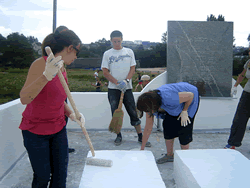
Guests from the Jewish Federation of Greater Atlanta during the visit to Camp on Wheels
The camp always begins with an intensive two-day educational seminar where participants learn about the Jewish legacy of the local area and listen to lectures on subjects ranging from synagogue architecture to deciphering tombstone inscriptions. The teachers are all Russian speaking experts and professors. For example, one of the teachers is an expert on epitaphs on Jewish tombstones and Jewish cemeteries in the Pale of Settlement.
This summer, the first term of Camp on Wheels focused on renovating the Jewish cemetery in Volozhin. Volozhin is the site of one of the most prominent yeshivas of Lithuanian (non-Chassidic) Judaism. The Jewish community of Volozhin and the yeshiva peaked in the 19th century and was already in decline by WWII. Under Nazi occupation, the Nazis mercilessly executed the Jews of Volozhin and extinguished any remnant of Jewish life. Today, there are only a few Jews living in Volozhin and none was born there.
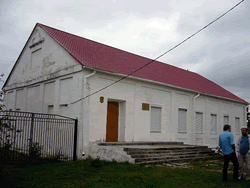
The famous Volozhin yeshiva overlooks the cemetery
Before the campers tended to the cemetery it looked like a large overgrown field with tombstones here and there, and a large memorial tombstone for R. Chaim of Volozhin in the middle that was falling apart.

A memorial for the Jews of Volozhin who perished in the Holocaust
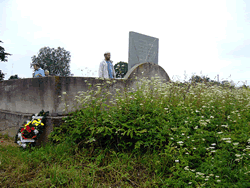
Large memorial tombstone of R. Chaim Volozhiner
Today, thanks to the campers and other volunteers, the site of the cemetery has been mowed and the gravestones carefully catalogued for further research. The fence around the cemetery and R. Chaim Volozhiner's grave have been restored and repainted.
In previous years, Camps on Wheels focused on renovating historic synagogues and yeshivas. Each year, campers stay in very simple accommodations and work under the supervision of experts, applying the skills they learned from a pre-camp seminar. After a few days of work the students embark on an educational tour of Jewish heritage sites and former shtetls, covering five locations each day. An educational component is connected to each site. The program of this year's Camp on Wheels takes the participants from destruction (abandoned cemetery in Volozhin) to rebirth (a synagogue in Grodno that is being rebuilt).
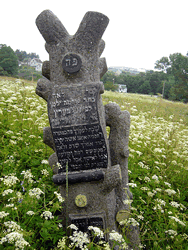
Tree of Life Tombstone with the branches cut off
Participation in Camp on Wheels makes a profound impact on participants. A powerful educational tool, the camp connects students to what is essentially their family history in a very direct, hands-on way. Many participants have gone on to do genealogical research after the camp, discovering previously unknown family stories and sharing them with other participants. Some campers got a head start on Hebrew while deciphering epitaphs, and today speak fluently. Others have found friends for life. All of them connected to a shared heritage and a common past, and are now strengthened in building a common future.
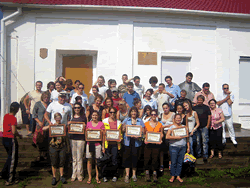
Group shot of Camp of Wheels participants and the delegation of the Jewish Federation of Greater Atlanta
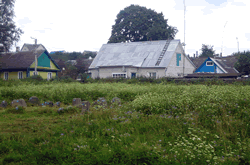
The Jewish cemetery in Volozhin before the Camp on Wheels participants' hard work and renovation.
If you would like to know more about Camp on Wheels, or other Jewish Agency summer camps, please contact Anya Zhuravel at anyaz@jafi.org
